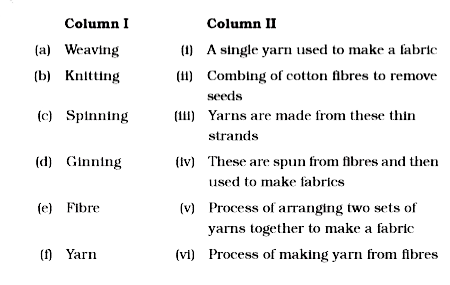Match the term given in column I with its description in Column II
Column I Column II(a)Path function (p)Heat(b)State function (q)Internal energy (c)Intensive property(r)Entropy(d)Extensive property (s)Specific heat
The correct Answer is:(A)-(p) (B)-(q),(r) (C)-(p),(s) (D)-(q),(r)
To solve the problem of matching the terms in Column I with their descriptions in Column II, we will analyze each term and its corresponding description step by step.
Step 1: Analyze "Path function"
- Definition: A path function is a property that depends on the specific path taken during a process. In thermodynamics, the two primary path functions are work and heat.
- Match: The description that corresponds to a path function is "Heat" (p).
Step 2: Analyze "State function"
- Definition: A state function is a property that depends only on the initial and final states of a system, regardless of the path taken. Examples include internal energy, enthalpy, and entropy.
- Match: The appropriate matches for state functions are "Internal energy" (q) and "Entropy" (r).
Step 3: Analyze "Intensive property"
- Definition: Intensive properties are those that do not depend on the amount of substance present. They are inherent to the material itself. Examples include temperature and specific heat.
- Match: The correct match for an intensive property is "Specific heat" (s).
Step 4: Analyze "Extensive property"
- Definition: Extensive properties are those that do depend on the amount of substance present. Examples include mass, volume, and total internal energy.
- Match: The extensive property corresponds to "Internal energy" (q) and "Entropy" (r) as they depend on the amount.
Final Matches:
- (a) Path function → (p) Heat
- (b) State function → (q) Internal energy and (r) Entropy
- (c) Intensive property → (s) Specific heat
- (d) Extensive property → (q) Internal energy and (r) Entropy
Summary of Matches:
- A → P
- B → Q & R
- C → S
- D → Q & R
- Definition: A path function is a property that depends on the specific path taken during a process. In thermodynamics, the two primary path functions are work and heat.
- Match: The description that corresponds to a path function is "Heat" (p).
- Definition: A state function is a property that depends only on the initial and final states of a system, regardless of the path taken. Examples include internal energy, enthalpy, and entropy.
- Match: The appropriate matches for state functions are "Internal energy" (q) and "Entropy" (r).
- Definition: Intensive properties are those that do not depend on the amount of substance present. They are inherent to the material itself. Examples include temperature and specific heat.
- Match: The correct match for an intensive property is "Specific heat" (s).
- Definition: Extensive properties are those that do depend on the amount of substance present. Examples include mass, volume, and total internal energy.
- Match: The extensive property corresponds to "Internal energy" (q) and "Entropy" (r) as they depend on the amount.
- (a) Path function → (p) Heat
- (b) State function → (q) Internal energy and (r) Entropy
- (c) Intensive property → (s) Specific heat
- (d) Extensive property → (q) Internal energy and (r) Entropy
- A → P
- B → Q & R
- C → S
- D → Q & R
Topper's Solved these Questions
- THERMODYNAMICSBOOK - MODERN PUBLICATIONCHAPTER - THERMODYNAMICSEXERCISE - Competition File (Integer Type Questions)
6 Videos
- THERMODYNAMICSBOOK - MODERN PUBLICATIONCHAPTER - THERMODYNAMICSEXERCISE - Unit Practice Test
12 Videos
- THERMODYNAMICSBOOK - MODERN PUBLICATIONCHAPTER - THERMODYNAMICSEXERCISE - Competition File (Matching Type Questions)
2 Videos
- STRUCTURE OF ATOMBOOK - MODERN PUBLICATIONCHAPTER - STRUCTURE OF ATOMEXERCISE - Unit Practice Test
13 Videos
Similar Questions
Knowledge Check
Match the process given in column I with its description given in column II.
 A(i)-(C) , (ii)-(D), (iii)-(B), (iv)-(A)B(i)-(B) , (ii)-(A), (iii)-(C), (iv)-(D)C(i)-(C) , (ii)-(A), (iii)-(B), (iv)-(D)D(i)-(C) , (ii)-(D), (iii)-(B), (iv)-(A)
A(i)-(C) , (ii)-(D), (iii)-(B), (iv)-(A)B(i)-(B) , (ii)-(A), (iii)-(C), (iv)-(D)C(i)-(C) , (ii)-(A), (iii)-(B), (iv)-(D)D(i)-(C) , (ii)-(D), (iii)-(B), (iv)-(A)Match the terms given in Column I with expressions given in Column II.
 A
A B
B C
C D
D
Match the terms given in Column I with the units given in Column II.

View SolutionMatch the terms given in Column I with expressions given in Column II.

View SolutionMatch the terms given in Column I with the compound given in Column II.

View SolutionMatch the terms given in Column I with the statements given in Column II

View SolutionMatch the terms given in Column I with the compounds given in Column II.

View SolutionMatch the terms given in Column I with the compounds given in Column II.

View Solution


